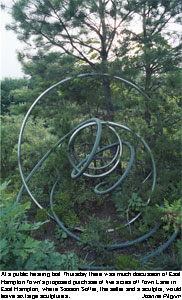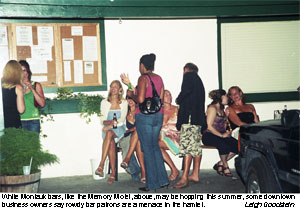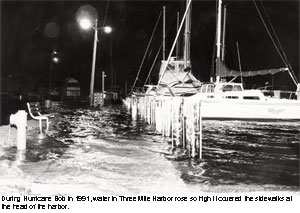Ian Hornak: Creating An Art Apart
Ian Hornak: Creating An Art Apart
Ian Hornak's house, invisible behind its blinding floodlights, was silent one dark, rainy evening last week except for little waterfalls dripping off the roof. Nothing moved. It could have been some remote rainforest.
Suddenly Mr. Hornak emerged from the shadows: He'd been sitting on the terrace, waiting and watching. A tall, strapping, blond man in safari clothes, he led the way into a small but elegant house with a huge studio.
Formidably flamboyant paintings blazed from the dark walls: a vase of riotously unsettling flowers, a portrait of a preening macaw, a bowl of demented-looking tulips. Combined with some chaotically gesturing potted plants and his two pet parrots, they deepened the exotic spell, evoking a kind of wild kingdom.
Michigan Farm Roots
Mr. Hornak introduced Paco, a mild-mannered, dapper, red-lored Amazon, and Rowdy, a larger, scruffier, and rather intimidating yellow nape. He fetched a plate of homemade scones from the kitchen and sipped a gin and tonic as he talked.
While his work has variously been compared to German Romanticism, Dutch genre painting, Realism, Surrealism, and Photorealism as it evolved over the years, it has eluded classification or association with any one school, making its own independent way from its plain American roots on a dairy farm in Michigan, where the artist grew up.
Born in Philadelphia in 1944 to a Czechoslovakian father and an American mother educated in Prague, Mr. Hornak was 8 when the family moved to the Middle West.
Self-Taught
"We had a lot of milk cows and a couple of riding horses, grew hay and wheat, and did a little truck farming," he said. "It was a good way to grow up. When I wasn't doing chores I rode around with my little sister, Rosemary, piggyback on the horse in front of me."
There was also a younger brother, Michael, but Mr. Hornak was closest to Rosemary, who also grew up to become a painter and who remains his "best friend."
Earliest Work
Completely self-taught, he started drawing at age 3 or 4, concentrating on boats and museums. " 'Museum' is written in my mother's hand on some of these early drawings," he said. "I wasn't much of a prodigy, but I loved boats."
At 9, he received a set of oil paints and a book of famous paintings from the world's great museums as Christmas presents, and immediately began copying Raphaels and Michelangelos. "It was probably good that there were no art classes in school," he said.
In his bedroom today hang two paintings from this period. A self-portrait done at age 11 in the style of Raphael shows a Renaissance-type young man in a silk vest standing against a pale Italian landscape.
A portrait of the 8-year-old Rosemary in a black velvet dress with a white lace collar and cuffs has echoes of a Dutch interior. Both are exquisitely rendered, startlingly beautiful paintings.
"My mother was very encouraging about my art," Mr. Hornak said, "but my father wanted me to be a doctor or a lawyer. He thought I was wasting my time." Even so, he remembers that his father "did show my work rather proudly to his friends."
At the University of Michigan, and later at Wayne State University where he took an M.F.A. and also taught, Mr. Hornak experimented with surrealistic drawings of Renaissance-inspired mythological themes, often with nightmarish overtones, rendered in microscopic detail.
New York Art Scene
Gertrude Castle, who owned a gallery in Michigan, admired his work and gave him letters of introduction to various artists in New York City. Through her he met de Kooning and Motherwell, Fairfield Porter, and the realist painter Lowell Nesbitt, who introduced him to Claus Oldenberg, Robert Indiana, and others on the scene.
In the summer of 1968 Mr. Hornak sublet Nesbitt's huge studio on East 14th Street and, steeling himself to the bums and prostitutes on his doorstep, launched himself uncertainly into the New York art world.
"After a month I realized I could never go back to teaching at Wayne, so, with $700 in my pocket, no job, and, once Lowell came back, no place to live, I somehow found the courage to stay."
Tibor De Nagy
He lived with friends, found other sublets, and "got a stupid job teaching kids at an awful art school in Scarsdale, run by two absolutely monstrous little old ladies. That job didn't last long."
Stints at Bergdorf Goodman's men's department and Bloomingdale's kept the painter going until he was able to afford a place of his own.
In 1971 he had his first one-man show at Tibor de Nagy, a highly respected gallery that was promoting Abstract Expressionism at the time.
"It was very exciting and quite a coup," said Mr. Hornak. "Tibor was a great gent and we used to go to the opera together, but he wasn't interested in my work until he hired Jason McCoy, Lee Krasner's nephew, as his new director. Jason persuaded him to take me on."
The relationship lasted through six years of "great big successful shows," at first of figural paintings, usually nudes, within a vaguely pastoral border.
Sunsets And Rainbows
By the mid-70s the figures had disappeared and the borders had taken center stage, evolving into intensely romantic landscapes with outrageous sunsets and rainbows that "were very 19th-century," said Mr. Hornak, "in that nobody important had painted sunsets or rainbows since well before Frederic Church."
These works transmogrified into more exotic, complex scenes in which trees protruded through Japanesque mists at various horizon-levels, as in multiple-exposure photographs, one bleeding through another.
These dreamlike images caused the artist to be grouped with the Photorealists - wrongly, he felt.
Outrageousness
"I always fought inclusion with Photorealists," Mr. Hornak said. "I thought they were more connected to everyday things like snapshots of families standing in front of their cars in their backyards, than to my romantic landscapes." "Sure, I worked from photographs as I might have from sketches, but my paintings were much more outrageous and far-out, as if they'd come from a Frankenstein movie."
"One of the best compliments I ever got was from the cookbook writer Yvonne Tarr, who said about one of my flower paintings that there was something weird about it: It reminded her of Jack Nicholson, she said, leering like he did in 'The Shining.' "
Dreamlike "Otherness"
John Gruen, the Water Mill writer and critic, commented in Arts magazine that "the tinge of Surrealism that inhabits Hornak's work (and it is only a tinge) contrives to give his imagery an imperceptible 'otherness': Again, this 'otherness' is only to be found in dreams" - or nightmares.
In 1977 Mr. Hornak regretfully left Tibor de Nagy for the Fischbach Gallery, on the advice of a friend who thought its director, the late Aladar Marberger, who summered in the Hamptons, would promote his work more energetically.
Pan-Seared Halibut
For six years the artist prospered at Fischbach until Mr. Marberger fell ill and began spending less time at the gallery; he died of AIDS in 1989. Differences with his successor caused Mr. Hornak to leave Fischbach; for four difficult years he was without a regular gallery.
In 1988 the Katherina Rich Perlow Gallery took him on, on the strength of seeing just one painting. He has showed there ever since, and is excited to be having the opening show at her new space in SoHo early next month.
"Our relationship gets better and better as time goes on," he said.
Mr. Hornak first came to East Hampton in 1971, mostly for summers and weekends. In 1974, when he hooked up with his partner of many years, Frank Burton, they began living here year-round.
Dark Interlude
Here he developed what he considers his best work, although the paintings did not sell. Dark landscapes and night scenes done in the mid-'80s, along with what some saw as morbid tropical landscapes, led him to seek treatment for depression.
Gradually, these landscapes evolved into the gaudy flower paintings of his more recent oeuvre, works celebrating the chutzpah and flashiness of orchids, wildflowers, lilies, and the parrots he often posed with them.
The devastation of Mr. Burton's illness and eventual death from lung cancer a little over a year ago stopped this exuberant style in its tracks.
New Still Lifes
The artist's latest works, mostly more subdued and classically beautiful still lifes, will be in his new show.
One especially vivid painting is triumphantly life-affirming, however: three lobsters on a silver platter near a bowl of lima beans, against a verdant landscape with a waterfall.
"It's very red and green," Mr. Hornak said with obvious relish. "Somewhat surrealistic, quite outrageous, and really sort of shocking."



